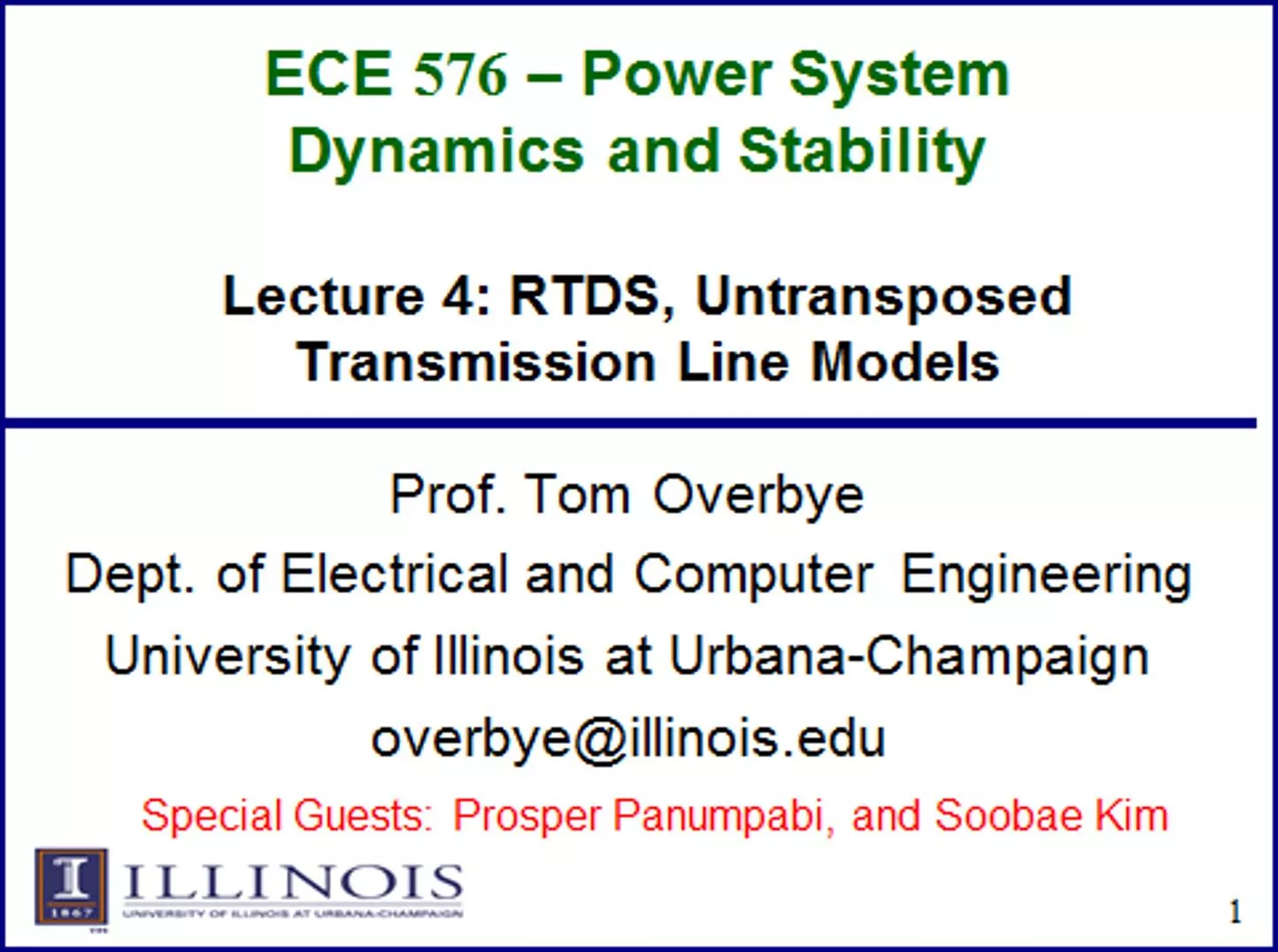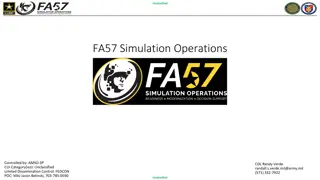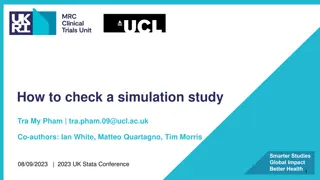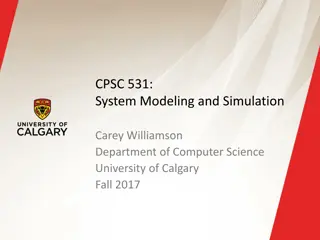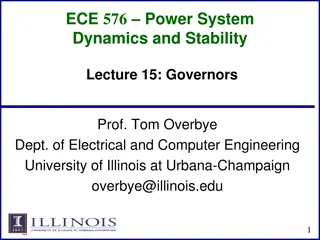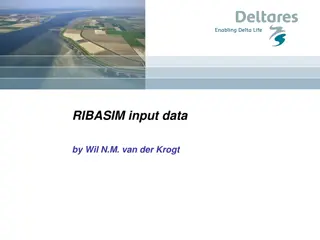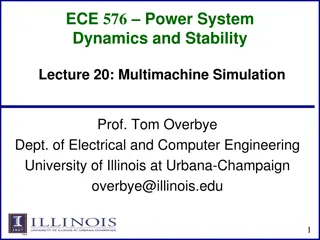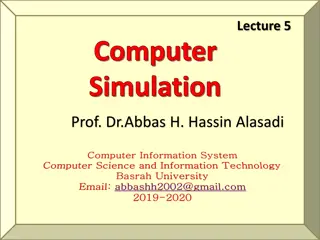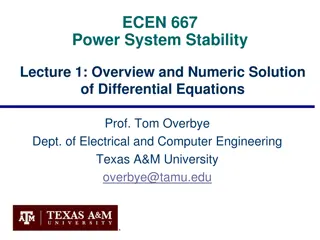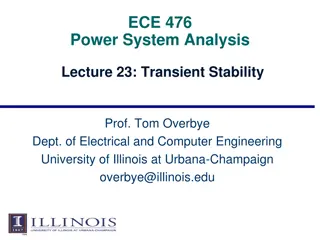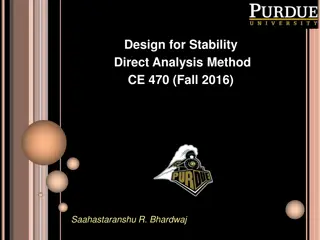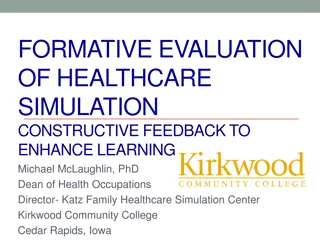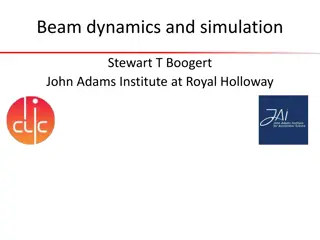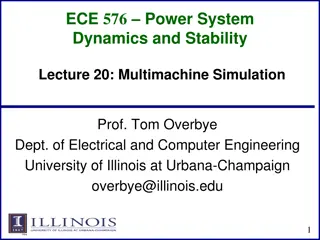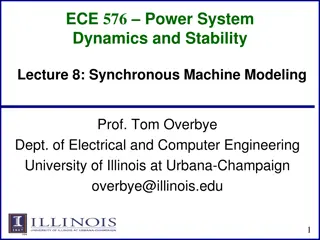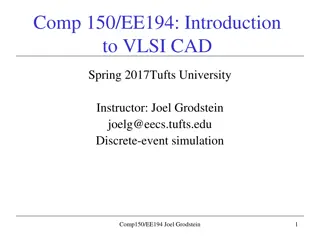Power System Dynamics and Stability Simulation
Simulation of power system dynamics and stability using the Real-Time Digital Simulator (RTDS). This advanced system allows for real-time integration with physical hardware and offers high-speed processing and communication. Discover how the RTDS simulator is utilized in various industries such as the airline and power industries, as well as by electrical power companies and educational institutions. Learn about the fastest electromagnetic modeling techniques in power lines and how distributed models using traveling waves play a crucial role in analyzing transmission lines. Dive into examples of voltage and current computations in lossless transmission lines.
Download Presentation

Please find below an Image/Link to download the presentation.
The content on the website is provided AS IS for your information and personal use only. It may not be sold, licensed, or shared on other websites without obtaining consent from the author.If you encounter any issues during the download, it is possible that the publisher has removed the file from their server.
You are allowed to download the files provided on this website for personal or commercial use, subject to the condition that they are used lawfully. All files are the property of their respective owners.
The content on the website is provided AS IS for your information and personal use only. It may not be sold, licensed, or shared on other websites without obtaining consent from the author.
E N D
Presentation Transcript
ECE 576 Power System Dynamics and Stability RTDS Simulator for Power Systems Simulation Flight Simulator Airline Industry Power Industry RTDS Simulator Electromagnetic transient solution (EMTP type simulation) Based on the Dommel algorithm Trapezoidal rule of integration New solution produced each timestep Dedicates high speed processing and signal communication required to achieve real-time Integration with physical hardware Dedicated high speed processing and high speed communication 3
ECE 576 Power System Dynamics and Stability RTDS Simulator for Power Systems Simulation Users: Electrical Power Companies: Southern California Edison, Dominion Virginia Power, KEPCO Electrical Manufactures Companies: SEL, Research and Educational Institutions: UIUC, Florida State University, Clemson University, Quanta Tech, 4
RTDS Testbed at University of Illinois at Urbana-Champaign Two racks RTDS : PB5(3), GPC (2), GTWIF(2), GTDI (2), GTDO(2), GTAI (1), GTSYNC (2), GTFPI(2), GTAO (2), GTNET: C37.118 (2), DNP3(1), IEC61850(1), Playback (2)
Fastest Electromagnetic Modeling in Power Lines Distributed model using travelling wave: A voltage disturbance will travel almost at the speed the light till at the end of the line where it will be reflected: positive and negative waves Three ways to represent the transmission lines: 1. PI model: don`t capture any behave out of the fundamental frequency, suitable for short-lines 2. Bergeron Model: Infinite number of Pi sections are represented (work for the fundamental frequency) 3. Frequency Dependent Model: To be used for all frequencies studies as fundamental, transient over-voltages, harmonics, ..
Fastest Electromagnetic Modeling in Power Lines Consider a single-phase lossless transmission line below: Example 2.1. Compute the values of voltages and current, at time t = 0.001, 0.002 and 0.007 sec
Fastest Electromagnetic Modeling in Power Lines The case has been modeled in RSCAD
Fastest Electromagnetic Modeling in Power Lines The t-line Bergeron model has been compiled In PSSE and exported in RSCAD
Fastest Electromagnetic Modeling in Power Lines Solving the case in the Run mode:
Fastest Electromagnetic Modeling in Power Lines Exporting RTDS results to an Excel Sheet Time Breaker v1 v1 v2 i1 i2 0.066 0 187.557 0.0821693 0.0798849 1.87E-04 1.80E-04 0.0661 0 187.779 0.0821309 0.0802444 1.87E-04 1.83E-04 0.0662 1 187.735 0.0819757 0.08049 1.88E-04 1.86E-04 0.0663t=0 1 187.424 187.423 0.0806212 1.88E-04 1.88E-04 0.0664t=0.0001 1 186.846 186.845 0.0806377 0.684264 1.90E-04 0.0665t=0.0002 1 186.003 186.002 0.0805396 0.682156 1.92E-04 0.0666 1 184.895 184.895 0.0803269 0.679078 1.93E-04 0.0667 1 183.525 183.525 0.0800001 0.675035 1.94E-04 0.0668 1 181.894 181.894 186.509 0.670034 1.95E-04 0.0669 1 180.005 180.004 339.439 0.66408 0.0347197 0.067t=0.0007 1 177.86 177.859 310.211 0.657182 0.126974 Note: The RTDS simulation need a delay for components to solve, reason why the RTDS close the breaker at time 0.0663 and not 0.
Fastest Electromagnetic Modeling in Power Lines Comparing Results with Peter Sauer solution:
Fastest Electromagnetic Modeling in Power Lines Zoom the first instant of simulation: RTDS solution Exercice 2.1 Peter Sauer Book ECE 576 RTDS solution Exercice 2.1 Peter Sauer Book ECE 576 400 400 300 300 200 200 100 100 v1 and v2 v1 and v2 0 0 -100 -100 -200 -200 -300 -300 0 0.05 0.1 0.15 0.2 0.25 0.3 0.35 0.06 0.065 0.07 0.075 0.08 Time sec 0.085 0.09 0.095 0.1 Time sec
Fastest Electromagnetic Modeling in Power Lines Special Cases: Load Impedance = Characteristic Impedance T1.1 1 0 %3d %3d 60.00 60.00 1.000000 0.0 0.0 / %3d %3d 0.54772 273.86 0.0 0.0 1.000000e+00 / NO REFLEXION
Fastest Electromagnetic Modeling in Power Lines Special Cases: Two adjacent lines
Fastest Electromagnetic Modeling in Power Lines Special Cases: Two adjacent lines 300 250 200 150 Voltage v1, v2, v3 100 50 0 -50 -100 Course RTDS -150 -200 0 0.01 0.02 0.03 0.04 0.05 0.06 0.07 0.08 Time sec PWFullMatrixGrid Variables 300 300 250 250 200 200 150 150 Voltage v1, v2, v3 100 100 Values 50 50 0 0 -50 -50 -100 -100 -150 -150 -200 0 0.002 0.004 0.006 0.008 0.01 0.012 0.014 0.016 0.018 0.02 -200 Column 1 0.028 0.03 0.032 0.034 Time sec 0.036 0.038 0.04 Column 2 Column 3 Column 4
Fastest Electromagnetic Modeling in Power Lines Studying a power Line within a large power system using PowerWorld and RTDS





